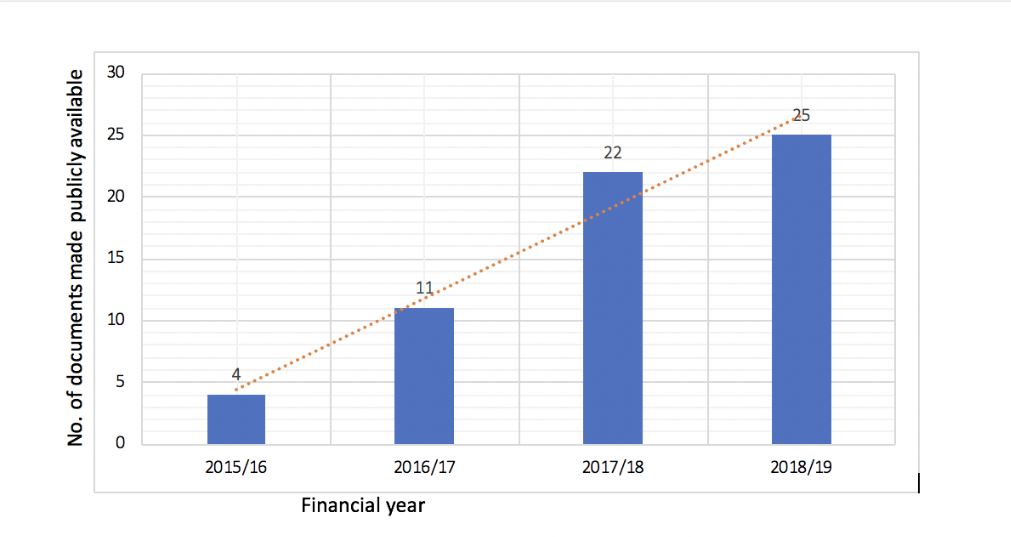Last week, the International Budget Partnership Kenya released its findings from the second round of this year’s Kenya County Budget Transparency Survey - a bi-annual survey that helps measure Kenya’s 47 counties’ efforts to make available information critical to public participation and oversight.
Borrowing from the Open Budget Survey, we look at official county government websites to assess the availability of key county budget documents that should have been made available to the public at each stage of the budget process as required by the Public Finance Management Act, 2012. The following findings are based on the sub-national surveys conducted by IBP over the past four fiscal years.
- Evidence shows counties are publishing more budget information, but local budgeting remains far from fully transparent
This September, the survey recorded the highest ever average of budget documents that were published by Kenya’s sub-national units.
Forty two percent (42%) of the documents that were meant to be published and publicised in line with the PFM law were available on the county websites.
The previous highest recorded average was twenty five percent (25%) in our September 2017 study.
In general, when all the surveys are aggregated into fiscal years, data since 2015 shows a very slow but steady year-on-year increase in the number of documents made publicly available from seventeen percent (17%) in FY 2014/15 to twenty one percent (21%) in FY 2017/18.
For example, the number of counties publishing Annual Development Plans has been growing steadily since FY 2015/16 when we first checked for these plans.
However, while there is general improvement, the availability of budget reports at the individual county level is sporadic, indicating that individual counties are not consistently publishing budget documents.
While September 2018 survey recorded the lowest number of counties that did not publish any budget reports, the growth has been far from consistent.
The study in March 2018 had record 35 counties that had not published any documents.
In the two surveys carried out in March and September 2017 35 and 20 counties had not published any budget document respectively.
Therefore, the number of counties publishing documents has been erratic across the eight studies an indication that the growth could be an indication of some counties publishing more documents.
Despite recent improvements, there is no guarantee that counties will keep publishing more documents based on the number of counties that IBP found with documents online in each survey.
That number has not been consistently growing and the good performance in the September 2018 survey could easily reverse.
- Citizen budgets: counties are not publishing this key ingredient for public engagement
Citizen engagement is generally agreed to be an essential ingredient in a healthy democracy.
Kenya’s devolution has created some public interest on how counties, the devolved units, spend public money.
Citizen budgets should be a first step in providing information for non-technical readers to understand, interrogate and appreciate budget decisions made by their counties.
While every budget document should ideally be accompanied by a simplified summary, Kenya’s Public Finance Management Regulations for county governments only require counties to publish simplified versions of Budget Estimates for effective public participation.
Despite the importance of citizen budgets, our survey data shows that only three counties have ever published citizen budgets since the onset of devolution.
Even though the data shows that governments are increasingly making budget proposals publicly available, questions still need to be asked on whether the information contained in the proposals is suited for public engagement.
- Successful initiatives to monitor budget performance are impossible without implementation information, yet counties are not proving this information in the public domain.
Concerns about the implementation of budgets remain a pressing concern in Kenya today.
Historically, information on budget execution was produced after very long delays, resulting in the lack of useful information for preparing subsequent budgets by the legislature and line ministries.
In addition, the public was not able to access information on budget execution to be able to engage with that part of the budget process.
Currently, the PFM law requires that counties produce and publish quarterly budget implementation reports.
However, our research indicates that counties do not adhere to this requirement.
Generally, it is not clear whether the reports are produced and not published or both.
These reports are also intended to ensure that the county assemblies can provide proper oversight and make changes when necessary before the budget year is over.
The public can similarly use implementation reports to ensure that their priorities are being implemented and to ask questions when they are not.
The Public Finance Management Act, 2012 requires that quarterly budget implementation reports be prepared within 30 days of the end of each quarter.
In all the surveys carried out by IBP, only one county out of the 47 in Kenya had made a quarterly budget implementation report available to the public online since the onset of devolution.
Baringo County has been the only consistent producer of budget implementation reports.
It comes as no surprise, therefore, that civil society budget work in Baringo county has shown the most significant improvement.
- Demand for budget transparency is still almost exclusively driven by CSOs
In the past three surveys, we have shared the preliminary results with all the 47 county governments to give them an opportunity to ascertain their accuracy before releasing the final results.
This September, after the initial results were shared with counties, the number of documents on county websites went up by 68%.
Specifically, 21 counties published documents after the initial results were shared, including 14 counties who did not have any documents available during the initial assessment.
This improvement indicates that counties may be responding to IBP’s findings and striving to do better. Some have reached out and given an indication that they would like to publish more documents to improve their score.
However, pressure by civil society (and other oversight actors) alone will not be enough to hold governments accountable for budget transparency.
Engagement with legally mandated oversight institutions needs to improve to address systemically weak budget oversight and to restore their function as citizen agents and as avenues for citizen engagement.
Ultimately, strengthening the system of oversight is the sustainable solution.
















